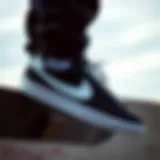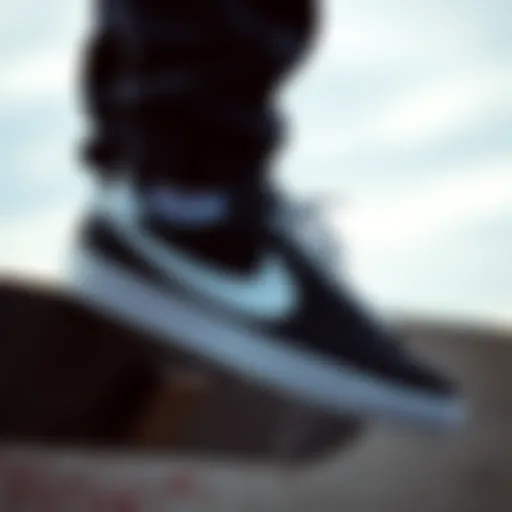Skateboard Shoes for Wide Feet: A Complete Guide
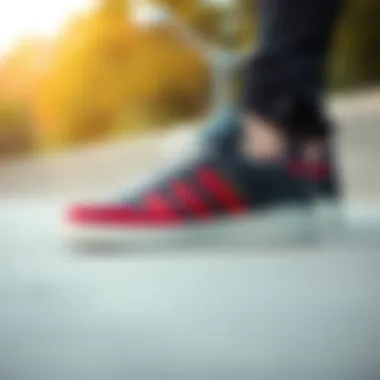
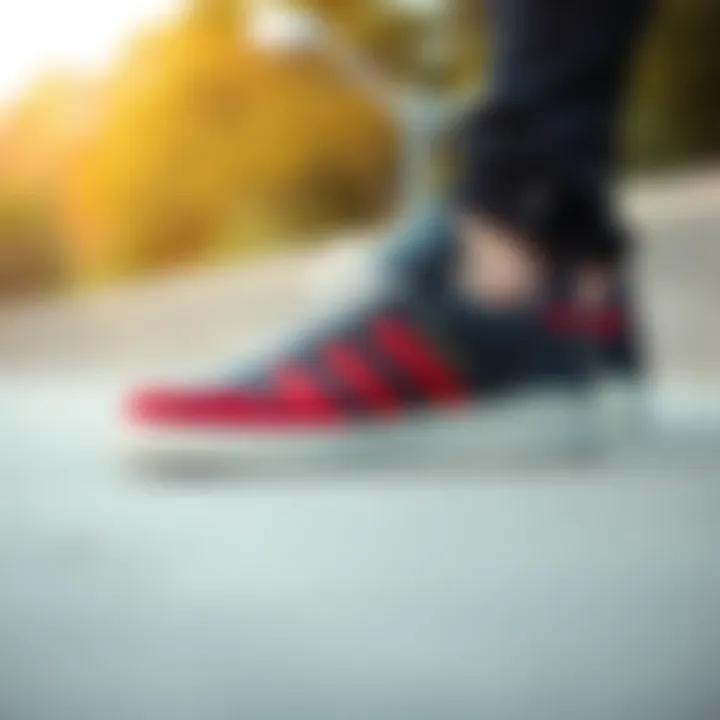
Intro
Skateboarding goes beyond just tricks and flips; it's a culture, a way of life. For those with wide feet, however, finding the right pair of skate shoes can feel like searching for a needle in a haystack. Not every shoe on the market is designed with this specific foot shape in mind, which can lead to discomfort and issues with performance. That's where this guide comes in.
Navigating the world of skateboard shoes tailored for wider feet requires understanding key elements like fit, performance, and style. In this guide, we will explore the importance of proper footwear in skateboarding culture and delve into crucial criteria you should consider when choosing the right sneakers. From assessing popular brands that cater to wider fits to highlighting important design features, we aim to arm you with the knowledge necessary to select the most suitable pair. Whether you're a seasoned skater or just dipping your toes into the sport, this guide will offer practical tips for a comfortable and enjoyable skating experience.
"Good footwear can make or break your skate session. If your shoes don’t fit right, you might as well be skating on marbles!"
This quote speaks volumes about just how essential foot comfort and support are in this activity. And with this in mind, let’s take a look at skills development, which ultimately ties back into having the right equipment.
Understanding Wide Feet
When it comes to skateboarding, footwear is not just about style—it's fundamentally about comfort and performance. For skaters with wide feet, selecting the right skateboard shoes can make a world of difference. This section delves into understanding wide feet, which is a crucial first step in ensuring that skateboarders can ride confidently without discomfort or risk of injury.
Defining Wide Feet
Wide feet, often described as feet that measure wider than the standard width, can present unique challenges when it comes to fitting into footwear. Typically, shoe sizes come with different width options: regular, wide, and sometimes even extra wide. Knowing where you fall on this spectrum is fundamental.
But how do you know if your feet are wide? It's not only about how it feels in the shoe; it's also about measurements. A quick way to determine this is to measure the widest part of your foot and compare it to standard shoe sizing charts, as many brands provide specific details on widths. If you're constantly squeezing into your skate shoes or feeling pinched after a few hours, it's likely time to address the width issue.
Common Foot Shapes
Feet come in various shapes, and understanding the common types can assist you in making informed decisions about footwear. Here are a few common shapes:
- Flat Feet: Tend to have a low arch, which can lead to additional width as well.
- High Arches: These may require more cushioning, but could also make the foot appear narrower.
- Wide Feet: As noted, this entails noticeably broader dimensions, leading to a need for spacious footwear.
When skaters know what shape their feet are, they can zero in on shoes that offer the best support and comfort. Choosing shoes designed for wide feet can help with not just fitting, but also with providing the right level of arch support and cushioning.
"Finding the right fit in skateboard shoes is not just about comfort; it's about optimizing your performance on the board."
In summary, understanding the aspects of wide feet and the common shapes is essential to navigating the sometimes tricky shoe-shopping landscape effectively. Whether skateboarding casually or at a competitive level, the right footwear is a cornerstone of every skater's setup.
The Importance of Proper Fit
When it comes to skateboard shoes, the fit is everything. Many may underestimate the role proper fitting plays in not only enhancing comfort but also impacting performance and safety on the board. Finding the right fit often translates to better control, agility, and a reduced risk of harm. So, let’s break down why ensuring a good fit should be high on any skateboarder's agenda, especially those with wide feet.
Impact on Performance
A well-fitting shoe can make the difference between a smooth ride and a constant battle with discomfort. For skaters with wide feet, this is particularly crucial. When shoes pinch or do not provide enough room, it can lead to limited foot movement. Picture this: you’re mid-trick, trying to land that kickflip, but your foot feels constricted—slipping from the board or losing balance becomes likely.
A shoe that fits right enables your foot to engage with the board effectively. The sensitivity of your foot to the deck is paramount, especially in executing tricks where precise foot placement is key. Some key points about proper fit impacting performance include:
- Better Board Feel: A snug fit without feeling tight allows for enhanced feedback from the board. You’ll feel every nuance of the surface beneath your feet.
- Precision in Tricks: With adequate space, you can execute flips, grinds, and other moves with more confidence.
- Durability: Shoes that fit well tend to experience less wear due to improper flex and pressure points.
Risk of Injury
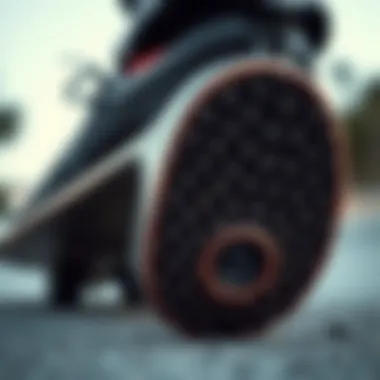
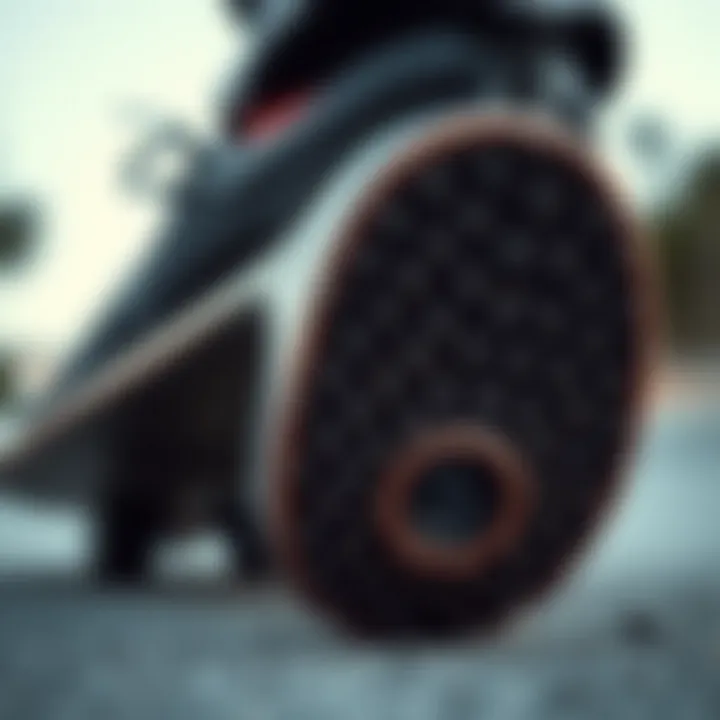
Skateboarding, while exhilarating, can also be unforgiving if the right precautions aren’t taken. Ill-fitting shoes can be a significant contributing factor to foot injuries. For wide-footed skaters, a mismatch in shoe size can lead to various issues:
- Blisters and Calluses: Too tight, and blisters become an unwelcome companion. Too loose, and your foot can slide around, causing friction.
- Ankle Support: Shoes that sit properly on your foot provide required ankle stability. Poor fit can compromise your ankle support during tricks, increasing the risk of sprains.
- Arch Pain: An improper fit can lead to overexertion of certain parts of the foot. This could cause strain on ligaments and muscles, leading to broader issues over time, such as tendonitis.
Choosing the right shoes isn’t just about style; it’s about ensuring your feet are protected while you pursue the thrills of skateboarding.
In essence, prioritizing fit can help skaters not only enjoy their time on the board but also safeguard against the potential risks that come with the sport. Always take the time to assess how a shoe feels when worn, and don’t shy away from trying various sizes and brands to find that perfect match.
Key Features of Skateboard Shoes for Wide Feet
When diving into the world of skateboard shoes, especially for those with wide feet, understanding the key features becomes crucial. The right shoe not only enhances performance but also ensures long-lasting wear and comfort. Choosing the right features can transform a mediocre skating experience into something remarkable. Let’s get into what matters the most.
Material Considerations
The materials used in skateboard shoes play a significant role in their overall performance, durability, and comfort. Opting for high-quality materials can spell the difference between a shoe that lasts and one that barely lasts a season. Skateboard shoes for wide feet often employ both synthetic and natural materials.
- Breathability: Shoes made with breathable materials, like mesh, keep your feet cool during long skating sessions. A sweat-soaked foot is a slippery foot and can lead to a lack of command over your board.
- Durability: Leather or synthetic leather offers durability, essential for the wear and tear skateboarders put their shoes through. High-abrasion uppers safeguard against scuffs and damage, critical when pulling tricks.
- Water Resistance: On the flip side, some skaters may prefer options with water-resistant features. While not every skater will be caught in the rain, having shoes that can weather a light drizzle without damage is beneficial.
- Weight: It’s a balancing act between durability and weight. Heavy shoes can drag you down, while lightweight options might not withstand constant use. Finding a middle ground where comfort meets resilience is key.
Support and Cushioning
Support and cushioning are non-negotiable when it comes to skateboarding footwear, especially for those with wider feet. A well-cushioned shoe absorbs impact, reduces fatigue, and keeps your feet from feeling like they’ve been through a war zone after a day on the board.
- Arch Support: Wide feet often need proper arch support to prevent discomfort and possible injuries. Shoes that lack adequate support can lead to a range of issues, from cramps to long-term structural foot problems.
- Cushioning Technology: Look for features like EVA foam or specialized internal cushions. These provide shock absorption, offering a smoother ride on hard surfaces. A variety of cushioning setups can be found, so it’s worth trying a few to discover what fits you best.
- Shank and Heel Support: Stiffer insoles and sturdy heels reinforce stability for broader frames. This support is crucial during tricks where balance can be the difference between hitting the ground or landing perfectly.
Outsole Design
The outsole is often the unsung hero of skateboard shoes, but it deserves ample attention. A properly designed outsole not only grips the board but also allows for better control and maneuverability.
- Grip and Traction: Look for a rubber outsole with a good tread pattern. Deep grooves provide grip, essential for maintaining control during ollies or flips.
- Flexibility: Skateboard shoes should flex at the right places. A rigid sole might offer durability, but if it doesn’t allow for foot movement, you can kiss your tricks goodbye. A blend of support and flexibility is ideal.
- Cup Sole vs. Vulcanized Sole: Both sole types have their pros and cons. While cup soles offer more cushioning and support, vulcanized soles provide better board feel. Wider-footed skaters should weigh the benefits of each, as individual preference varies widely.
- Weight Distribution and Balance: The outsole design should also consider weight distribution. An imbalanced shoe might make you feel like you're leaning one way or the other, which can hinder performance and lead to accidents.
"The right skateboard shoe can be your best friend on the board: supportive, durable, and perfectly fitting, it can transform your experience."
In summary, the key features of skateboard shoes for wide feet center around the right materials, sufficient support and cushioning, and an effective outsole design. Understanding these aspects will empower skaters to make informed decisions and enhance their overall performance.
Top Brands for Wide Feet
When it comes to skateboarding, the shoes a skater wears can make all the difference, especially for those with wide feet. The right fit isn’t just about comfort; it impacts performance and safety as well. Nowadays, there is a growing awareness of foot shapes and sizes, prompting top brands in the skate industry to cater to the needs of wide-footed skaters. From cushioning to traction, these brands offer styles that support the unique requirements of wider feet, ensuring that skaters can perform their best without unnecessary discomfort.
Nike SB
Nike SB has built a reputation in skateboarding shoes that resonates with enthusiasts globally. Their line includes a variety of models designed specifically to fit wider feet comfortably. Features like lightweight materials and responsive cushioning enhance board feel without sacrificing support. One standout is the Nike SB Dunk, known for its padded collar which provides extra comfort around the ankle. It’s a blend of style and function that works wonders for wider feet, making it a go-to for many skaters.
Adidas Skateboarding
Everyone knows Adidas means business when it comes to shoes. The Adidas Skateboarding line, especially their classic Superstar style, offers roomy toe boxes that pamper wider feet. With a focus on quality materials, their shoes promote durability in the face of intense skating sessions. The Boost technology found in some models adds an extra layer of comfort, making those long days on the board significantly easier. Wide-footed skaters can count on Adidas not just for their style but also for the assurance that the footwear will stand up to the rigors of skateboarding while respecting foot shape.


Vans
Vans has long been a staple in skate culture, becoming synonymous with skate shoes. The brand’s offerings for wide feet, particularly the Old Skool and Sk8-Hi styles, boast sufficient width and a flexible fit, ideal for skaters who need a bit more room. With a history steeped in skateboarding, Vans uses their heritage to tailor shoes that perform while also resonating with the lifestyle of skaters. The pleasure of pulling on a classic pair of Vans is that they now come with smart choices that support wider feet, retaining both functionality and style.
Shoes
DC Shoes captures the essence of skating with innovation and style. Their selection includes models designed with wide-footed skaters in mind, like the DC Court Graffik. DC is known for its sturdy construction, making it a reliable option for skaters who engage in aggressive styles. Moreover, the added ankle support in some models showcases how this brand balances aesthetic attractiveness with functional attributes for wider feet. The cushy insoles and durable outsoles ensure that wide-footed skaters won't find themselves compromising on either comfort or performance.
"The right skateboard shoes for wide feet can elevate your skating experience, allowing you to focus on your skills rather than your discomfort."
Evaluating Fit and Comfort
When it comes to selecting the right skateboard shoes, the focus often shifts to aesthetics or brand popularity, but no aspect is more crucial than evaluating fit and comfort. In a sport where your feet play a vital role in maintaining balance and executing tricks, wearing ill-fitting shoes can turn your ride into a frustrating experience, even for the most seasoned skaters. Thus, understanding how to accurately assess fit and comfort cannot be overstated.
Finding a comfortable pair that caters specifically to the shape and width of your feet can improve overall performance and enjoyment on the board. Moreover, it minimizes the risk of developing long-term foot problems, which can hinder skating in the future. For those with wider feet, the hunt for the perfect shoe can be even trickier; hence, the need to delve into various sizing techniques and the importance of an in-store experience.
Sizing Techniques
When it comes to figuring out your size, it goes beyond just picking a label off the rack. Here are some practical methods to ensure you find that right fit:
- Measure Before You Shop: It may sound simple, but many people skip this step. Grab a ruler or a measuring tape and determine your foot length and width at home. Don't forget to do it in the evening, as feet often swell and could end up being a size larger than in the morning.
- Bran-Specific Size Charts: Different brands often have their sizing quirks. It’s worth checking their online size chart or even printing it out to have at hand during your fit assessment. Adidas, for instance, might size differently than Vans.
- Use the Brannock Device: If you visit a skate shop, look for a Brannock device to get a professional measurement. This tool assesses both length and width, so you’ll know if you’re a wide EE or a standard D.
"The best fit remains subjective; what works for one person may not necessarily work for another, even if the numbers line up perfectly."
Remember, focus on both dimensions. Baseball bats and skateboard shoes both come in various shapes, and the correct width can make a significant difference.
Trying Before Buying
This cannot be emphasized enough: whenever possible, try on the shoes before making a purchase. A few minutes spent in the store can save you a world of pain later. Here’s what to look for:
- Walk Around: Test the shoes by walking around. Don’t just stand there like a statue; get a feel for how they behave when in motion. A shoe that feels good in the store might not perform well on the board.
- Check the Toe Box: Make sure there’s enough space at the front. Your toes should have a little room to wiggle without feeling cramped. If your toes are brushing against the end, they could suffer during long skate sessions.
- Feel the Support: Evaluate if the shoes provide the necessary arch support and cushioning. A good rule of thumb is to press the insole with your fingers to see if it's firm but flexible at the same time.
- Wear Your Skating Socks: Different thicknesses of socks can change how a shoe fits. Bring along the socks you typically wear while skating for the most accurate read on comfort.
Finding the right skateboard shoes for wide feet is no small feat, literally and figuratively. So take the time to size up correctly and try those kicks on for fit. It pays off, giving you the confidence and comfort needed to focus on nailing that next big trick.
Maintenance Tips for Skateboard Shoes
Keeping skateboard shoes in good shape is crucial for both performance and longevity. With the wear and tear they face while riding, proper maintenance not only prolongs their life but also ensures skaters can perform at their best. This section covers cleaning techniques and storage solutions that can help maintain the condition of skate shoes made for wide feet.
Cleaning Techniques
The grime of the skatepark can quickly accumulate on shoes, particularly for skateboarders who ride hard. Regular cleaning not only keeps the shoes looking fresh but can also enhance their performance. Here are several methods to consider:
- Brush Off Dirt: Using a soft-bristled brush, gently remove any loose dirt or debris. This can prevent the filth of the environment from grinding further into the material.
- Warm Water and Soap: For deeper cleaning, mix warm water with a mild detergent. Take a cloth or sponge and carefully scrub the shoes. Make sure to reach the seams and other crevices where dirt likes to hide. Rinse with a damp cloth afterward to remove any soap residue.
- Avoid Machine Washing: While it might be tempting to throw them in the washing machine, this can damage the materials and shape of your shoes. Hand cleaning is a much safer route.
- Air Dry: After cleaning, allow the shoes to air dry away from direct sunlight or heat sources. This prevents the material from cracking and maintains its shape.
"Cleaning your skateboard shoes regularly can feel like a chore, but it's one of the best ways to extend their life and performance."
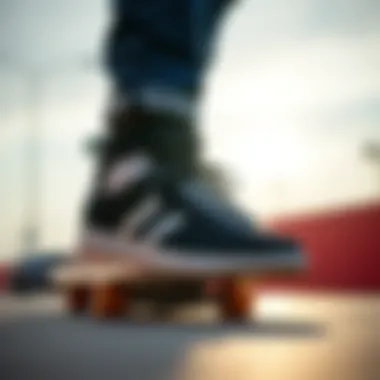
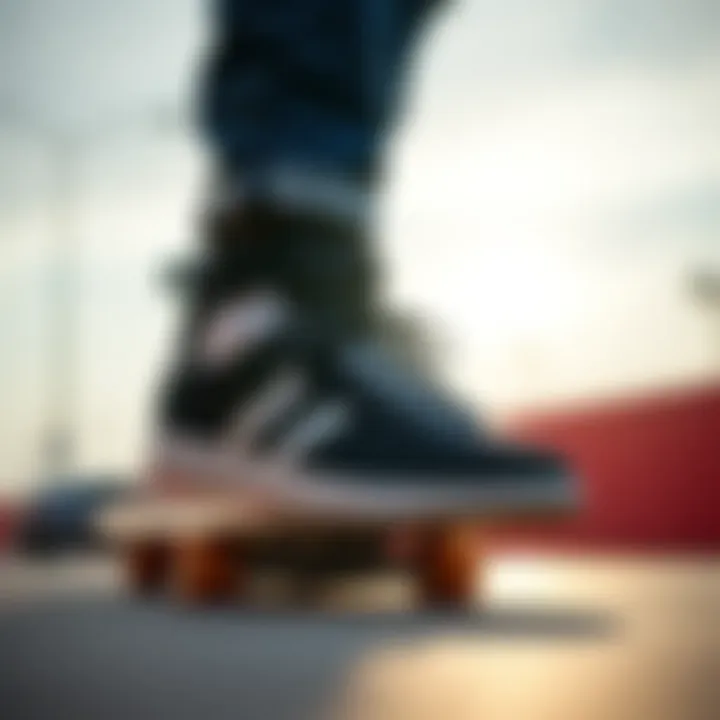
Following these steps ensures that your skateboard shoes not only look clean but perform better, which, let's face it, is everything in skateboarding.
Storage Solutions
Where and how you store your skateboard shoes can significantly impact their durability. Proper storage can help maintain the shape and integrity of the shoes:
- Keep Them Dry: Always store your shoes in a dry area. Moisture can lead to mold and unpleasant odors.
- Use Shoe Trees: Placing shoe trees in your shoes can help them retain their shape. This is particularly beneficial for wider shoes, which might otherwise lose their structure over time.
- Avoid Sunlight: Prolonged exposure to sunlight can fade colors and weaken material. Store them in a shaded area to keep them looking sharp.
- Separate from Other Gear: Keep your shoes away from sharp objects or other gear that might scuff or damage them. Using a designated bag or box can help protect them when not in use.
By implementing these cleaning and storage techniques, they can stay in optimal condition longer, giving skaters the performance they need without needing to invest in new shoes too often.
Cultural Impact of Skateboard Shoes
Skateboard shoes do not just serve a practical purpose; they are a cultural emblem within the skateboarding community. Over the years, the footwear has evolved from being mere sport-specific necessities to a significant fashion statement. Understanding the cultural ramifications of skateboard shoes helps appreciate the deeper intersection between performance and aesthetics.
History of Skateboard Footwear
The origins of skateboard shoes can be traced back to the late 1960s and early 1970s, when skateboarding began to gain traction as a mainstream activity. Early skateboarders used regular canvas shoes with a flat sole, but these provided little grip or support while riding. As skateboarding progressed, so did the demand for purpose-built shoes.
In the late 1970s, brands like Vans stepped in and began producing shoes specifically designed for skaters. Their waffle sole provided exceptional grip, which was crucial for performing tricks. By the 1980s, skate shoes began to feature padded collars for ankle support and improved cushioning to absorb impact. Notably, the emergence of the “skate culture” introduced shoe designs featuring vibrant colors and unique graphics, reflecting the individuality and rebellious spirit of the skateboard community. The partnership between skaters and brands truly launched the concept of skate shoes into a robust and dynamic market.
Evolution Through the Decades
- 1980s: The introduction of signature shoes by pro skaters revolutionized the industry. Names like Tony Hawk and Christian Hosoi became synonymous with their respective brands.
- 1990s: Skate shoes started to incorporate more advanced technology, focusing on durability and comfort. Designs became bulkier, and brands began to experiment with different styles.
- 2000s to Present: The blend of streetwear and skate culture led to an explosion of fashion-forward designs. Skate shoes transitioned into everyday streetwear, appealing to a broader audience while maintaining their core performance attributes. This era saw the rise of collaboration between skateboard brands and high-fashion labels, further embedding skate culture into the mainstream fashion scene.
The history of skateboard footwear underscores the symbiotic relationship between function and style, setting a foundation for their extensive cultural impact.
Fashion Trends in Skateboarding
Skateboard shoes have not merely followed fashion trends; they have often led them, becoming integral to an emerging culture. As skateboarding gained popularity, the shoes morphed into a canvas for self-expression. Here’s how:
- Casual Yet Stylish: Skate shoes are designed to be comfortable yet stylish, often seen in everyday settings beyond skate parks. The casual look appeals to a wide range of individuals, transcending age groups and backgrounds.
- Bold Colors and Graphics: In contrast to their early utilitarian designs, modern skate shoes often sport bold hues, prints, and patterns. This expressionism allows skaters to showcase their unique personalities and philosophies, contributing to a vibrant culture.
- Limited Editions & Collaborations: The trend of releasing limited edition skate shoes has taken off. Collaborations with artists, musicians, and designers reinforce the idea of skateboarding as a cultural force. Fans often seek out these limited releases, not just for their quality but for their collectibility and cultural status.
“Skate shoes are more than just footwear. They’re a statement of identity in the world of skateboarding and beyond.”
In essence, the evolution of skateboard footwear reflects shifting trends in wider societal aesthetics and cultural movements. As fashions come and go, skateboard shoes remain a resilient pillar, adapted to the times yet deeply rooted in the subculture that birthed them.
The End
In wrapping up our exploration of skateboard shoes tailored for wide feet, it's essential to recognize the critical convergence of fit, comfort, and performance. This guide has illuminated the nuanced world of footwear designed specifically for skaters with wider foot profiles, underscoring that the right pair of shoes can significantly impact not just performance, but overall enjoyment on the board. When skaters invest in shoes that accommodate their foot shape, they foster stability and control, enhancing its ability to execute tricks and maneuvers with confidence.
Summary of Key Points
To distill the essential takeaways:
- Understanding Wide Feet: Recognizing the distinct features of wide feet is foundational. Being aware of various foot shapes helps skaters appreciate the importance of footwear that caters to their unique structure, which is not merely about aesthetics but functions as a catalyst for improved performance.
- The Importance of Proper Fit: Emphasizing correct fit is crucial. Ill-fitting shoes can lead to discomfort and injuries, directly impacting a skater's abilities and enjoyment.
- Key Features of Skateboard Shoes: Shoes designed for skaters are built with specific features like enhanced support and cushioning, which are especially vital for those with wider feet.
- Top Brands: Brands such as Nike SB, Adidas Skateboarding, Vans, and DC Shoes lead the market in creating standout products for this demographic.
- Evaluating Fit and Comfort: Taking the time to evaluate fit through techniques such as sizing systems ensures optimal purchase decisions. Trying shoes before buying, when possible, cannot be overrated.
- Maintenance Tips: Proper care, including cleaning techniques and storage solutions, prolongs the life and performance of the shoes.
- Cultural Impact: Understanding the cultural significance of skateboard shoes provides insight into their evolution from mere functional wear to fashion statements within skateboarding culture.
Looking Ahead
As the landscape of skateboarding continues to evolve, so too does the footwear that supports it. The future holds exciting possibilities, from advances in materials that enhance breathability and comfort to designs that cater even more specifically to unique foot shapes, widening the choices for skaters facing fit challenges. By staying informed about new technologies and emerging brands, skaters can anticipate an expanding array of options tailored to their needs.
The journey doesn’t end here. Equipment choices will reflect personal style and function alike, creating a deeper connection between the skater and their gear. As brands recognize the diverse needs of the skating community, we can expect an influx of innovative products that embrace both performance and personal expression. Hence, making educated choices in skateboard shoes now prepares skaters for a thriving relationship with their sport for years to come.


